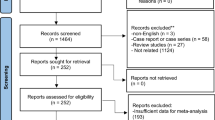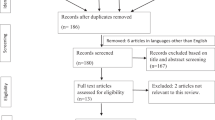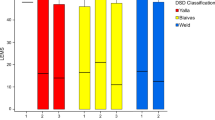Abstract
Study design
Case series.
Objective
Bladder chemodenervation is effective in treating neurogenic detrusor overactivity (NDO) in patients with neurogenic bladder due to spinal cord injury. Anecdotal reports also describe the improvement of non-bladder symptoms, specifically those related to autonomic dysreflexia (AD) and muscle spasticity. We conducted a study to further investigate this phenomenon.
Setting
USA, Urban Tertiary Care Center.
Methods
Twenty-one persons with SCI completed the study between March and December 2015. Mean age was 45 years (range 21–69). All were scheduled to undergo bladder chemodenervation with onabotulinumtoxinA 200 units to treat bothersome NDO refractory to oral medications. Each completed a questionnaire detailing symptoms unrelated to NDO immediately prior to the procedure, and again between 6 and 12 weeks after.
Results
All patients reported improvement in NDO symptoms following chemodenervation. Ten patients with prior symptoms of AD reported improvement in AD symptoms after injection. Seventeen patients reported skeletal muscle spasticity in the 3-month period before chemodenervation. In the follow up period, only 14 patients reported having muscle spasticity. In aggregate, 12 of 21 patients reported improvement of non-bladder symptomatology following chemodenervation.
Conclusions
Chemodenervation of the bladder in patients with SCI can provide ancillary benefits in addition to mitigation of lower urinary symptoms. The mechanism may be related to dampening the bladder’s ability to initiate noxious reflex responses.
Similar content being viewed by others
Introduction
Bladder chemodenervation has clear benefits for many persons with spinal cord injury (SCI) in the management of neurogenic detrusor overactivity (NDO). These include symptomatic reduction of bladder spasms and incontinence episodes [1,2,3], and improved bladder compliance [4]. Improvement in bladder spasms and incontinence allows for reduction in the use (and therefore side effects) of anticholinergic drugs, and increasing compliance minimizes the risk of upper urinary tract deterioration, and may avoid major reconstruction of the urinary tract [5].
In our experience, many persons with SCI who undergo bladder chemodenervation also report improvement in symptoms associated with autonomic dysreflexia (AD) and other SCI-related symptoms, such as muscle spasticity. These were initially brought to our attention by patients during clinic visits after their chemodenervation procedures. Given the frequency with which they were reported, we conducted a pilot investigation, prospectively examining the patient-reported occurrence of AD and muscle spasticity, before and after bladder chemodenervation.
Methods
We recruited persons with SCI for this case series study, after they were consented for bladder chemodenervation for management of NDO. All study participants provided written informed consent. Most presented with a complaint of bladder spasms with or without urinary incontinence. The enrollment occurred between March and December 2015. Patients were undergoing either their first or a repeat bladder chemodenervation procedure, and all procedures were performed by a single surgeon (CCY), with general anesthesia.
Patients completed a questionnaire immediately prior to the procedure, detailing symptoms associated with AD, skeletal muscle spasticity, and perceived bladder irritability. We queried patients on their symptomatology for the 3 months prior to the procedure. The instrument asked whether they had ever experienced AD; the presence and frequency of individual symptoms of AD, such as pounding headache, nasal congestion, sweating above the level of injury, chills, skin blotchiness; and the presence and frequency of skeletal muscle spasms. (To our knowledge, there is currently no validated self-reported measure for AD symptoms. This questionnaire was created for the purposes of our study and administered only to enrolled study subjects.)
The follow-up questionnaire was identical to the preoperative assessment but asked patients about their symptoms since the time of chemodenervation, and included an additional question asking if symptoms were improved as a result of the procedure. The questionnaire was mailed to the patients at 6 weeks after their procedure. If patients did not respond, they were contacted by phone by a study investigator.
Bladder chemodenervation was performed in the same manner on all subjects, using onabotulinumtoxinA (BOTOX®) 200 units suspended in 20 ml of injectable saline. The solution was distributed throughout the bladder via cystoscopically-guided intradetrusor injections, injecting 1 ml aliquots in a grid pattern [6, 7].
The IRB at our institution approved the study protocol. We certify that all applicable institutional and governmental regulations concerning the ethical use of human volunteers were followed during the course of this research.
Results
Twenty-five persons with SCI were enrolled in the study, and there was follow up data available for analysis on 21 patients. Group demographics are found in Table 1.
At baseline, 15 patients reported ever having AD symptoms, and 6 patients reported never having experienced symptoms of AD. Five of the 6 patients who had no previous symptoms of AD had an injury level at or below T6, and the remaining patient had an injury at T3. Only 10 of the patients reported any AD symptoms within the 3 months immediately prior to chemodenervation (Table 2).
The symptom frequency was highly variable for each individual AD symptom, but the majority of patients reported “never” to most of the symptoms listed, and if they experienced an AD symptom, the frequency was generally reported to be between less than once monthly, but occasionally up to a few times a week. Because of the low symptom frequency, it was sometimes difficult for patients to recall the timeframe of when these symptoms occurred.
In contrast to AD symptoms, skeletal muscle spasm was commonly reported and occurred frequently in this cohort. Fifteen patients reported daily skeletal muscle spasms, 2 reported muscle spasms several times a month, and 4 patients denied having muscle spasms in the 3 months immediately prior to bladder chemodenervation.
At follow up (approximately 6 weeks following injection), all patients experienced excellent improvement in their NDO symptoms. Table 2 summarizes the patient self-reports of their other symptoms. Ten patients reported experiencing AD symptoms in the follow up period. As discovered during the pre-operative questionnaire, individual AD symptom frequency was reported irregularly, and difficult to document. Thirteen patients reported having daily muscle spasms, 1 experienced muscle spasms a few times per week, and 7 denied having muscle spasms.
In aggregate, when asked if bladder chemodenervation had improved their AD symptoms or muscle spasms, 12 patients (57%) reported yes. This group included most of the patients who had previously experienced AD as well as 1 patient with no prior AD but reported bothersome skeletal muscle spasms in the preoperative period.
Discussion
In this small observational study, a majority of persons with SCI report an improvement in SCI-related symptoms following bladder chemodenervation. The benefit was primarily found in those who experience AD, but was also seen in 1 patient with lower injury level and no AD symptomatology who reported improvement in muscle spasticity. Despite no change in the total number of patients experiencing symptoms of AD following the procedure, a small number of patients with a history of AD nonetheless reported improvement (decreased frequency or intensity of AD) following the procedure. The number of patients reporting improvement in muscle spasticity was more clearly defined, likely because the symptoms occurred more frequently than the AD symptoms. Patients’ symptoms were still ameliorated at 6 weeks following injection, in concert with improved bladder symptoms, suggesting that they are directly or potentially indirectly a result of bladder chemodenervation. These observations merit further investigation with mechanistic studies.
In an analysis of 691 patients from two Phase III trials, Rovner et al. reported significant improvement in NDO-related urinary symptoms and urodynamic outcomes, after injection of 200 units of onabotulinumtoxinA [8]. Multiple other studies confirmed the improvement of cystometric capacity, maximum detrusor pressures, and bladder compliance [9, 10]. While these prior investigations have already defined the relationship between (bladder) symptom improvement and urodynamic parameters, the patient-reported findings in this small observational study begin to characterize how the treatment of bladder dysfunction may affect non-urinary symptoms in individuals with SCI.
The first principle in the management for AD is to remove any identifiable source of noxious stimuli. However, in chronic or recurrent AD, there is often no identifiable source or no effective manner to mitigate the AD response during known triggers, e.g., urinary catheter changes. Anti-hypertensive medications are the mainstay in the management of both acute and chronic recurrent AD [11,12,13], but these often result in hemodynamic lability. If bladder-provoked AD responses can be mitigated with bladder paralysis via chemodenervation, then cardiovascular lability can be avoided or decreased. Similarly, skeletal muscle spasms can be difficult to control [14,15,16], and if they are provoked by bladder spasms, bladder chemodenervation may provide some relief.
Possible mechanism of action
The neuropathology of SCI provides a possible physiological explanation for how the non-bladder (AD and muscle spasticity) symptom improvements occur with bladder chemodenervation. One primary result of a spinal injury is a loss of inhibition on spinal reflexes below the level of injury. Neural mechanisms of reflex inhibition arise at the level of the spinal cord and the cerebral cortex [11, 17]. AD symptoms are the result of uninhibited, and therefore amplified, autonomic nervous system (ANS) reflex responses to noxious stimuli. Autonomic manifestations such as elevated blood pressure, sweating, vasodilation, and other disturbances occur due to disinhibition and loss of modulation of these reflexes. Elevated intravesical pressure, whether generated by a bladder contraction or bladder overdistention, is a noxious stimulus that can precipitate AD in patients with high spinal injuries.
Intravesical pressure can also precipitate abdominal and lower extremity spasms through local segmental reflexes in the lumbosacral spine. Afferent S1–S3 signals from bladder contractions or increases in intradetrusor pressure inappropriately trigger L1–L5 efferent responses resulting in skeletal muscle contractions. This occurs due to lack of spinal modulation of the inciting afferent stimuli. In both situations (AD, skeletal muscle spasms), ameliorating elevated detrusor pressure through bladder chemodenervation results in less severe, less noxious afferent signal transmission, and therefore mitigation of an inappropriate reflex response.
Fougere et al. performed a study demonstrating the attenuation or elimination of hypertension due to AD in 17 persons with SCI during urodynamics before and after bladder chemodenervation [18]. That study also showed a similar result with ambulatory blood pressure monitoring outside of the urodynamics suite. Patients self-reported less AD symptoms 4 weeks following the procedure. Prior to this study, amelioration of AD with bladder chemodenervation was only anecdotally reported. This current study corroborates the phenomenon and suggests that these ancillary benefits are more far-reaching than originally thought, and should be better characterized with further study. Detrusor chemodenervation can improve autonomic symptoms and skeletal muscle symptoms, and the response extends beyond the period reported in the Fougere study.
This study is limited by its preliminary nature as a pilot study, use of an unvalidated instrument, small sample size, and absence of physiologic data (e.g., vital signs documenting AD symptoms). As well, the low frequency of some reported AD symptoms made it difficult for patients to report accurately. However, we believe that the improvement in non-bladder symptoms in this subgroup of neurogenic bladder patients is real; in our experience, these improvements are in part what motivates these patients to return for repeat chemodenervation. A number of our patients report improvement in non-bladder symptoms, and identify the bladder as the source of their abdominal or lower extremity spasticity and/or AD. Finally, there is a reasonable neurophysiological basis for the symptom improvement. Bladder chemodenervation should not be considered a first line treatment of AD symptoms or skeletal muscle spasms, but future research should clarify which persons with SCI would benefit most from bladder chemodenervation as an adjunctive treatment for AD. Similar studies can be done for patients with severe abdominal and lower extremity muscle spasticity.
Chemodenervation of the bladder with onabotulinum toxin A in persons with SCI has ancillary benefits in addition to mitigation of lower urinary symptoms. The mechanism may be related to dampening the bladder’s ability to initiate noxious reflex responses.
References
Goessaert AS, Everaert KC. Onabotulinum toxin A for the treatment of neurogenic detrusor overactivity due to spinal cord injury or multiple sclerosis. Expert Rev Neurother. 2012;12:763–75.
Kalsi V, Apostolidis A, Popat R, Gonzales G, Fowler CJ, Dasgupta P. Quality of life changes in patients with neurogenic versus idiopathic detrusor overactivity after intradetrusor injections of botulinum neurotoxin type A and correlations with lower urinary tract symptoms and urodynamic changes. Eur Urol. 2006;49:528–35.
MacDonald R, Monga M, Fink HA, Wilt TJ. Neurotoxin treatments for urinary incontinence in subjects with spinal cord injury or multiple sclerosis: a systematic review of effectiveness and adverse effects. J Spinal Cord Med. 2008;31:157–65.
Giannantoni A, Mearini E, Del Zingaro M, Porena M. Six-year follow-up of botulinum toxin A intradetrusorial injections in patients with refractory neurogenic detrusor overactivity: clinical and urodynamic results. Eur Urol. 2009;55:705–11.
Kennelly M, Dmochowski R, Schulte-Baukloh H, Ethans K, Del Popolo G, Moore C. et al. Efficacy and safetyof onabotulinumtoxin A therapy are sustained over 4 years of treatment in patients with neurogenic detrusor overactivity: Final results of a long-term extension study. Neurourol Urodyn. 2017;36:368–75.
Schurch B, Stöhrer M, Kramer G, Schmid DM, Gaul G, Hauri D. Botulinum-A toxin for treating detrusor hyperreflexia in spinal cord injured patients: a new alternative to anticholinergic drugs? Preliminary results. J Urol. 2000;164:692–7.
Schurch B, Schmid DM, Stohrer M. Treatment of neurogenic incontinence with botulinum toxin A. N Engl J Med. 2000;342:665.
Rovner E, Dmochowski R, Chapple C, Thompson C, Lam W, Haag-Molkenteller C. OnabotulinumtoxinA improves urodynamic outcomes in patients with neurogenic detrusor overactivity. Neurourol Urodyn. 2013;32:1109–15.
Ginsberg D, Gousse A, Keppenne V, et al. Phase 3 efficacy and tolerability study of onabotulinumtoxinA for urinary incontinence from neurogenic detrusor overactivity. J Urol. 2012;187:2131–9.
Cruz F, Herschorn S, Aliotta P, et al. Efficacy and safety of onabotulinumtoxinA in patients with urinary incontinence due to neurogenic detrusor overactivity: a randomised, double-blind, placebo-controlled trial. Eur Urol. 2011;60:742–50.
Kurnick NB. Autonomic hyperreflexia and its control in patients with spinal cord lesions. Ann Intern Med. 1956;44:678–86.
Braddom RL, Rocco JF. Autonomic dysreflexia. A survey of current treatment. Am J Phys Med Rehabil. 1991;70:234–41.
Krassioukov A, Warburton DE, Teasell R, Eng JJ.Spinal Cord Injury Rehabilitation Evidence Research Team A systematic review of the management of autonomic dysreflexia after spinal cord injury. Arch Phys Med Rehabil. 2009;90:682–95.
Francisco GE. Intrathecal baclofen therapy for stroke-related spasticity. Top Stroke Rehabil. 2001;8:36–46.
Francisco GE, Boake C. Improvement in walking speed in poststroke spastic hemiplegia after intrathecal baclofen therapy: a preliminary study. Arch Phys Med Rehabil. 2003;84:1194–9.
Knutsson E, Lindblom U, Martensson A. Plasma and cerebrospinal fluid levels of baclofen (Lioresal) at optimal therapeutic responses in spastic paresis. J Neurol Sci. 1974;23:473–84.
Rabchevsky AG. Segmental organization of spinal reflexes mediating autonomic dysreflexia after spinal cord injury. Prog Brain Res. 2006;152:265–74.
Fougere RJ, Currie KD, Nigro MK, Stothers L, Rapoport D, Krassioukov AV. Reduction in bladder-related autonomic dysreflexia after onabotulinumtoxinA treatment in spinal cord injury. J Neurotrauma. 2016;33:1651–7.
Acknowledgements
The funding was provided by W.E. Bradley Family Foundation.
Author information
Authors and Affiliations
Corresponding author
Ethics declarations
Conflict of interest
The authors declare that they have no conflict of interest.
Rights and permissions
About this article
Cite this article
Haynes, B.M., Osbun, N.C. & Yang, C.C. Ancillary benefits of bladder chemodenervation for SCI neurogenic bladder. Spinal Cord Ser Cases 4, 83 (2018). https://doi.org/10.1038/s41394-018-0116-1
Received:
Revised:
Accepted:
Published:
DOI: https://doi.org/10.1038/s41394-018-0116-1



